Art Structure That Looks Like Bridge at Park Entrance in Nyc
By SERGEY KADINSKY
Forgotten NY correspondent
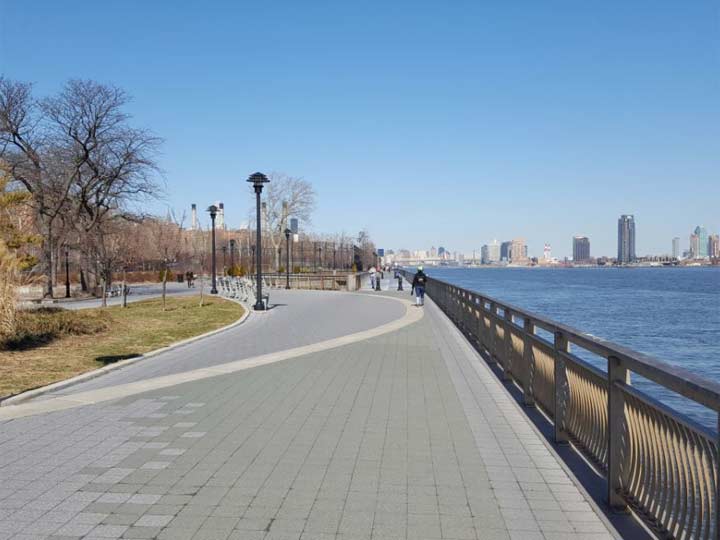
On a bend of the Due east River on Manhattan'southward Lower East Side is a park named after this waterway and recently co-named after a former mayor. In contrast to Riverside Park with its Olmstedian layout, complex topography, and access, the 57.v-acre Eastward River Park has only seven entrances along its 1.3-miles of waterfront, with the FDR Drive separating information technology from the Lower East Side neighborhood. Information technology is a production of Robert Moses, who sought to residue the highway with a park and give this crowded corner of Manhattan much-needed dark-green space.
Historical Overview

Since colonial times this been has been known equally Corlears Hook, after the Van Corlear family that owned land here in the Dutch days. As New York'southward seaport grew, the entire East River shoreline beneath Turtle Bay was lined with piers and ferry docks protruding into the h2o. The area was rough and tumble, known through the xixth century non as the Lower East Side, but as Corlears Hook, a standalone term for the southeast tip of Manhattan. Alter came in 1883, when Assemblyman Timothy J. Campbell proposed a waterfront park for Corlears Claw. The park opened on June 22, 1896 on a superblock spring by Ruddy, Jackson, South, and Corlears Streets. In the post-obit year a similar slum-to-park project was completed, Columbus Park on the site of the former Five Points.

The design of the park's initial comfort station resembled the 1 in Union Square while its circular pathways were reminiscent of Tompkins Square. Corlears Hook Park was redesigned in the late 1930s, with FDR Drive slicing through the park. With the highway project a new condolement station was built, straight paths, and a pedestrian bridge to the new Eastward River Park. By then this sometime park was much further from the shore while all the same preserving in its name the original southwest tip of the borough.

Prior to the construction of Williamsburg Bridge in 1903, the ferries at G Street and Houston Street took travelers to Brooklyn and points e. The Yard Streets of Brooklyn and Manhattan were continued past gunkhole, equally were their 2 Fulton Streets. The in a higher place 1921 Bromley map of Corlears Hook shows Williamsburg Bridge between the two ferry docks. Because the span landing was deep inland, the ferries remained a viable transportation choice for travelers living and working shut to the shore. These ii ferries ran until December 31, 1918. The ferry'due south Brooklyn landing is today a small park.

By 1930 the Houston Street Ferry was gone. I outlined the present streets on this map. When the city built public housing projects information technology often preserved existing public schools within the new superblocks. In the process this meant saving small segments of older streets that would not accept survived. Thanks to Public Schoolhouse 97, pieces of Mangin, Goerck, and Stanton Streets were preserved within Baruch Houses. Goerck was later renamed Baruch Place, not to be confused with nearby Baruch Bulldoze. Today this edifice is the Bard College High School, but the lettering above the school's entrance still has its old name. Its collegiate gothic design is the work of prolific public school builder C.B.J. Snyder, famous for Erasmus Hall and John Jay College, among other places. Dorsum in 2000, Kevin Walsh published a detailed necrology of the local streets that are no longer with u.s. as a consequence of urban renewal and superblocks.

About Houston Street's end at Due east River was the Tertiary Street Recreation Pier, one of many such parks that projected into the water. Enclosed by a roof, it hosted concerts. The residuum of the shoreline in 1930 was still a warren of coal and lumber yards that received their deliveries past boat from their sources in New England.

The dramatic changes began on August 28, 1935 when Mayor Fiorello H. LaGuardia took the seat in a steam shovel and mowed down the derelict Grand Street Ferry dock. Hundreds of residents and a marching bang cheered him on as construction commenced on Eastward River Park. Like many Robert Moses projects, this was to exist a highway with a park. While much of the parkland along FDR Drive comprises of the extremely sparse East River Esplanade and a few playgrounds on the road's inland side, at East River Park, land was extended into the state of war to create a wide lip of park infinite.
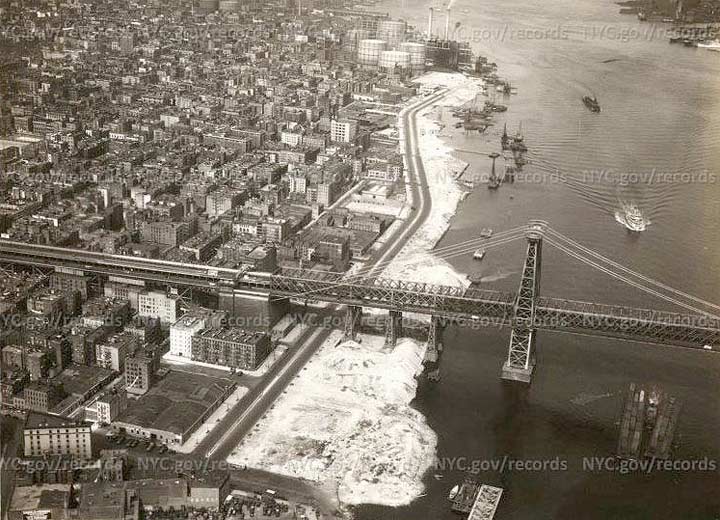
The shoreline transformation at East River Park was the starting time of its kind in the urban center, with 1.five miles of piers, warehouses, and docks demolished in favor of a waterfront park. This industry-to-parkland on the waterfront includes contemporary examples such as Hudson River Park, Brooklyn Bridge Park, and Gantry Plaza. East River Park was the get-go such park in the metropolis.

Representative of its decade, the comfort stations in East River Park feature Art Deco patterns around its doors, just certainly not as flashy as its privately-built genre representatives Chrysler Edifice, and the apartments of Grand Concourse. Behind this condolement station is the Brian Watkins Tennis Center, named subsequently the Utah tourist killedby subway muggers in 1990 while defending his parents. The murder fabricated national headlines and spurred a sustained crackdown on crime in the city. Watkins was in town for the U.S. Open, and it made sense for swain tennis lover Mayor David Dinkins to name a set of public courts for him.
Pier 42

The southern archway to East River Park is at Montgomery Street by Pier 42. The last of Manhattan's cargo piers, it received its last shipment of Ecuador bananas in November 1987. With that last order, the centuries-long part of the East River every bit an international port had ended. Whatever piers remain on Manhattan'due south e side today are either recreational or ferry docks. Afterward about three decades of uninspiring use equally a parking lot, the pier is being redesigned into an 8-acre park that volition preserve elements of the pier shed's structure.

What is old is new again. 83 years after Mayor LaGuardia demolished the Thou Street ferry dock, a new dock is being congenital at Corlears Hook for NYC Ferry. The service will connect Lower East Side residents to Wall Street, Midtown, Williamsburg, Long Island Metropolis, and Astoria, among other places.
Fireboat Station

Corresponding to Thou Street is a brick tower in the park that is the former FDNY Marine Company half dozen. This structure dates to 1941 only the first fireboats were moored at this location every bit far back as 1877. As the industrial use of East River declined, so did the need for fireboats.

In 1994, the FDNY transferred this facility to Parks. It was and then leased to the Lower Eastward Side Ecology Center, which installed a green roof atop this former fireboat station.
Brockovich Steps In
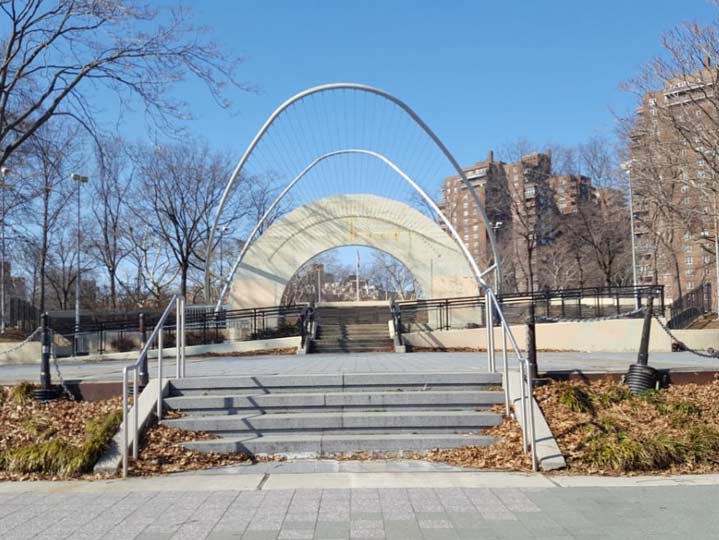
At the bend in the shoreline that is Corlears Hook, an amphitheater fits right in. The present phase was funded in 2001 by consumer rights activist Erin Brockovich as part of an ABC episode titled Challenge America With Erin Brockovich: The Phenomenon in Manhattan . The project'due south budget was $iv 1000000 with a 6 twenty-four hour period timeframe and pro bono labor provided past Tishman Structure.

The Brockovich bandshell is a humble replacement for the original 1941 theater, which has been in a state of ruin since at least 1973. The in a higher place photo is from Parks Archives. Its brief moment of glory was in 1956 when Joseph Papp ran a costless production of Julius Caesar here. The post-obit summer his show relocated to Central Park, where it runs to this twenty-four hours.
H2o's Edge

Another long-awaited project for East River Park was its seawall. Nature hates seawalls, sending waves crashing confronting them until they bear witness signs of crumbling. In the 2001 restoration, the shoreline appears the same as in 1940 but the promenade runs atop piers with a softer riprap shoreline beneath joggers' feet that absorbs waves and enables for marine life to flourish. At East 5th Street, a cove was carved from the seawall where the public can hear and watch the waves crash. I wish that Eastward River Park had more of such coves.
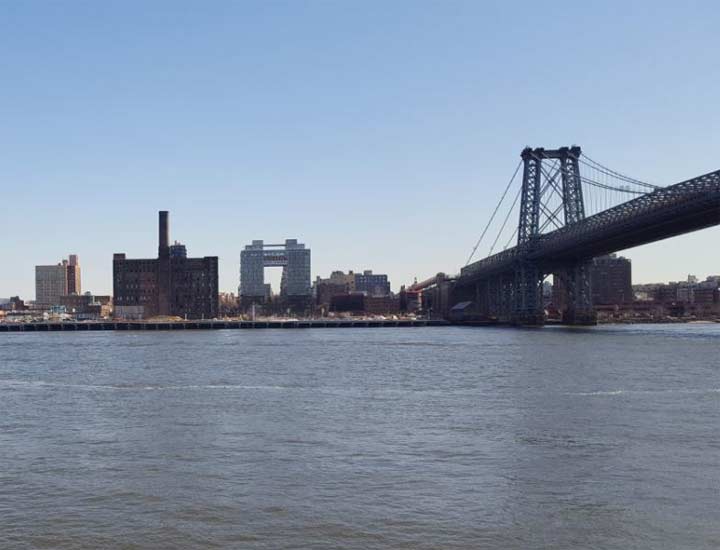
Across the East River the in one case-industrial Williamsburg shoreline is having its own transformation with the former Domino Sugar Refinery beingness redeveloped into a residential complex. A couple of cargo cranes on the property were repainted and preserved every bit art pieces in a new park. To their left, the smokestack of M Ferry Park is visible.
Baruch Bath House

From the park looking inland one notices an abandoned square building amongst the public housing towers. This curiosity led me dorsum beyond the FDR Drive to what was the city's outset public bathhouse and a reminder of when Rivington Street ran up to the East River. The facility opened in 1901 as the Rivington Street Public Bathroom, vital at a time when many nearby apartments did not have showers and bathtubs. In 19117, information technology was renamed after Dr. Simon Baruch. The namesake is a pioneering medical researcher who promoted residential restrooms and public bathhouses.

Today the abandoned Dr. Simon Baruch Public Bathroom is enveloped past the campus of Baruch Houses with Baruch Playground on its side. A 2007 CityArts landscape Rut Dances to the Sun's Beat decorates its eastern side, designed by James Evans and Adam Peachy. Urban explorers tried over the years to become into this ruin over the years but all of its doors and windows take been bricked shut since 1975.

A 1930 belongings survey shows the Baruch bathhouse surrounded by tenements. I drew a royal line to show everything that volition be razed here in the 1950s in favor of public housing and the Baruch Playground (in green) The bathhouse would the lone holdout within this perimeter. Land for the playground was acquired for the city past Simon's son Bernard Baruch, a noted financier and namesake of Baruch Higher.

Fortunately the photo collection at Museum of the Urban center of New York has an outside of the bathhouse from its early on years and a shot of its indoor puddle. The closest contemporaries of this structure that are open to the public today are the East 54th StreetRecreation Center and the Asser Levy Recreation Centre, which have gyms, showers and pools inside Beaux-Arts design buildings.

In the 2d half of the 20th century every bit apartments became more sanitary and bathhouses took on a seedy reputation, the Rivington Street Municipal Bath vicious into disrepair. It airtight in 1973 and has been abandoned since so. Considering the price of restoring the structure and the existing public pools nearby at Hamilton Fish Park and Dry Dock Playground, it is highly unlikely that this bathhouse will ever have its taps turned on once again.
North and South Ends

At the southern archway to the park is a sign announcing its full name, John 5. Lindsay East River Park. In a region where most everything was once named after its location the recent trend is at present to accolade politicians. Ed Koch for Queensboro Bridge, Herman "Denny" Farrell for Riverbank State Park, etc. For all the claim of honoring Mayor Lindsay, requite the man his own plaza or monument, but why rename an entire park? Besides, there'south also a drive inside Central Park carrying his name.
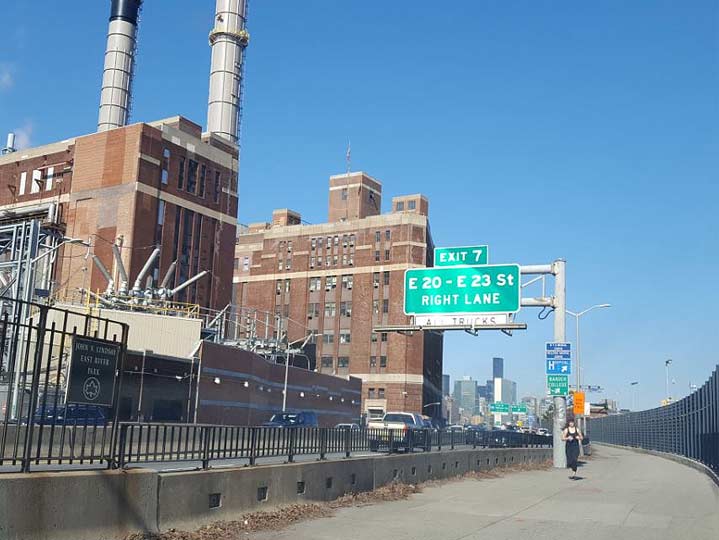
At the northern tip of East River Park the path narrows between the highway and the water's edge. The massive 14th Street power constitute dominates the skyline, the last industrial behemothic in a corner of Manhattan in one case known as the Gashouse Commune. Much of this old neighborhood is today'south Stuyvesant Town.

Looking north from Avenue D, the smokestacks accept the look of a precisionist painting. Retrieve of Charles Demuth or Charles Sheeler. Their works can be found at the Whitney Museum. Having gone far from East River Park, time to end this tour and return on some other 24-hour interval to see what else is left of this former district.
Sergey Kadinsky is the writer ofHidden Waters of New York City: A History and Guide to 101 Forgotten Lakes, Ponds, Creeks, and Streams in the Five Boroughs ( 2016, Countryman Press )
Check out the ForgottenBook, accept a await at the gift store, and as always, "comment…as you come across fit."
three/6/18
Source: https://forgotten-ny.com/2018/03/east-river-park-2/
0 Response to "Art Structure That Looks Like Bridge at Park Entrance in Nyc"
Post a Comment